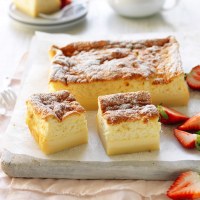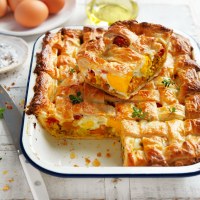How to make custard from scratch
Custard is a basic recipe that is so versatile. Delicious on pies, crumbles, in trifles, with pudding or even just with a scoop of ice cream, it's such a comforting dessert that's surprisingly easy to make. Learn how to make custard at home with the recipe and video below, plus see our top tips to get perfect custard every time.
Basic Vanilla Custard Recipe
Ingredients:
300ml pure cream
300ml milk
6 egg yolks
2 tablespoons cornflour
1 teaspoon vanilla bean paste or vanilla pod
75g (1/3 cup) caster sugar
Method:
- Combine cream and milk in a medium saucepan over medium heat and bring to just a simmer. If using a vanilla pod, add it at this stage.
- Meanwhile, whisk yolks, cornflour, vanilla and sugar together in a large heatproof bowl, until eggs turn pale and the sugar is dissolved.
- Using a whisk, temper the mixture (see notes below) then whisk in the hot cream mixture until smooth.
- Return mixture to cleaned saucepan and place over low heat. Cook, stirring constantly with a spoon, until custard thickens and thickly coats the back of a spoon. Set aside to cool slightly.
Tips for whisking the egg yolks and sugar together
Whisk eggs and sugar together until eggs turn pale. This process helps to dissolve the sugar and break up the egg yolks, so it is easier to incorporate the milk and cream. You do not need to beat air into the mixture. Adding the cornflour at this stage helps to stop the flour from forming lumps.
Why do you heat the milk and cream first?
If you are flavouring the milk and cream with vanilla pods or any other aromatic, this increases the transfer of flavours. Warming the milk also helps with tempering of the egg yolk mixture.
What does tempering mean in cooking?
Tempering in cooking is when you gradually add two mixtures at different temperatures together. In this custard recipe, it refers to adding the hot milk and cream to the relatively cool egg mixture in batches. If you add the two together all at once, the eggs will scramble. Start by adding 1/3 of the hot milk while whisking. Once the mixture is smooth, the rest of the milk can be added all at once.
What type of sugar should I use for custard?
Caster sugar is an all-purpose sugar and great for all types of baking. It dissolves easily into the egg yolks because it is finer than standard white sugar.
White sugar or pure icing sugar may be substituted. For this recipe, use 75g of any sugar. If measuring by cup, you will need to adjust the quantity. You may need to whisk for longer if using white sugar to ensure sugar is dissolved.
What type of vanilla should I use for custard?
Vanilla pods are the best way to add vanilla flavour to custards. Split the bean down the middle and scrape out the seeds with the back of a knife. Add to milk along with the pod and warm gently.
If you can't get your hands on a vanilla pod, vanilla bean paste or vanilla extract work well instead. These will impart a wonderful aroma. For a more intense vanilla flavour, stir vanilla paste or extract through at the end of cooking instead.
How do you know when custard is cooked?
While stirring, allow custard to come to a slow boil, that is you only need to see 1-2 large bubbles appear on the surface at the centre of the saucepan. Remove from heat immediately to avoid overcooking.
Coat your spatula with the custard and run your finger through it. If the line you made stays, the custard is done. Custards should be thick, glossy and smooth.
Why does my custard taste eggy?
An overly eggy taste means your custard has cooked at too high a temperature.
How long does custard keep in the fridge?
Cooked custards are very stable and can be made up to 3 days ahead. Allow cooked custard to cool on the bench before refrigerating.
How do I stop a skin forming on the top of my custard?
Cover with a sheet of cling film and make sure it touches the surface of the custard to prevent a skin forming on top.
How do you reheat custard?
You can reheat custard in the microwave or on the stove.
Microwave method: Microwave for 1 minute, stir, then microwave in 30 second intervals, stirring each time. Continue until it reaches serving temperature. If it is too thick, add a little milk. Serve immediately.
Saucepan method: Heat in a saucepan over low heat, stirring continuously. If it is too thick, add a little milk. Heat to serving temperature and serve immediately
Now that you have all the know-how to make custard at home, enjoy it with all your favourite desserts or in a recipe below.
GET THE RECIPE: Decadent Chocolate Custards by Australian Eggs
You won't believe how easy and delicious these rich chocolate desserts are.
GET THE RECIPE: Portuguese Custard Tarts by Australian Eggs
Learn to make these Portuguese Custard Tarts from scratch at home.
GET THE RECIPE: Easy Custard Berry Trifle by Australian Eggs
Why wait for Christmas to have this dessert when you can enjoy it all year round?















